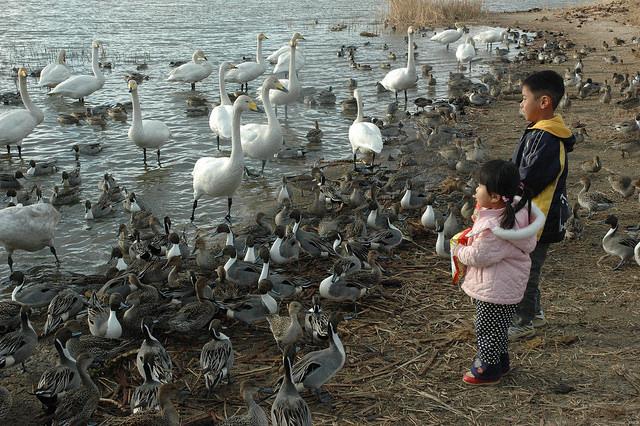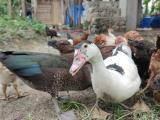The World Health Organization (WHO) today sounded an alarm about a number of signals that suggest that influenza strains, especially avian ones, are co-circulating and swapping genetic material at an unprecedented level.
In a statement today, the WHO said the world needs to be concerned about the diversity and spread of avian flu viruses in wild and domestic birds, factors that could give rise to more novel strains and threaten livelihoods, the food supply, and even human health.
The group said it is also concerned about several phenomena occurring alongside avian flu detections in birds, including genetic drift in the seasonal H3N2 virus that may have rendered this year's Northern Hemisphere flu vaccine less effective, continuing H7N9 infections in China, and a spurt of H5N1 illnesses in Egypt.
Against that backdrop, several countries in the past 3 days have reported more highly pathogenic avian influenza (HPAI) in wild birds and poultry to the World Organization for Animal Health (OIE). They include the United States, Taiwan, Hungary, Myanmar, and Vietnam, and the strains include H5N8, H5N1, H5N2, and H5N3.
Worries about H5, H7, and H9N2 signals
The WHO said the diversity and geographic distribution of avian flu viruses in wild and domestic birds hasn't been seen before since scientists have started using modern surveillance and genetic analysis tools.
The agency added that it is most concerned about H5 and H7 stains, because they rapidly change and can cause a range of illness severity in poultry. It added, however, that H9N2 avian influenza needs to be closely watched, as well, because it has provided "donor" genes to H5N1 and H7N9 strain and has resulted in two mild human infections in China in the last 4 months. Egypt also reported a recent H9N2 human case.
Though little is known about the ability of the latest novel strains to infect people, the H5N6 reassortant first detected in China last March has turned up in two other Asian countries and has caused three human infections in China, two of them fatal.
The WHO said the emergence of so many novel viruses has contributed to a diverse gene pool, made all the more volatile by the ease with which H5 and H9N2 viruses exchange genes with others. "The consequences for animal and human health are unpredictable yet potentially ominous," the WHO said.
Egypt's spurt of human H5N1 cases has eclipsed the yearly total for any country since the virus reemerged in 2003. And the WHO said United Nations Food and Agriculture Organization (FAO) data show that that between Jan 18 and Feb 7, Egypt reported 76 outbreaks of H5N1 in poultry in 20 of its 27 governorates, with most of the detections in household poultry.
So far preliminary lab analysis has found no major genetic changes that would explain the surge of human cases, but the WHO added that Egyptian officials think widespread virus circulation in poultry and the large number of households that keep flocks, without fully understanding the disease risks, could be responsible.
Though the world is somewhat better prepared for a pandemic since its experience with the 2009 H1N1 virus, it is still highly vulnerable to a pandemic that would cause severe disease, the WHO said. "An influenza pandemic is the most global of infectious disease events currently known. It is in every country's best interests to prepare for this threat with equally global solidarity."
Countries report flurry of outbreaks
Several countries battling different avian flu viruses have provided recent updates to the OIE, and Hungary yesterday reported its first H5N8 outbreak, marking its first HPAI detection since 2007.
Hungary's outbreak occurred at a duck farm in Bekes County, located in the southeastern part of the country, about 118 miles east of Budapest. The virus was found after farm workers noticed symptoms and increased deaths in the birds. All of the roughly 22,000 susceptible birds are slated for culling.
In two separate notifications to the OIE, US officials reported four new H5N2 detections and three new H5N8 findings.
The H5N2 virus was found in a captive horned owl in Canyon County, Idaho, a red-tailed hawk as part of wild bird surveillance in Benton County, Wash., a hunter-gathered mallard duck in Walla Walla County, Wash., and in backyard birds that had been exposed to wild migratory waterfowl in Deschutes County, Ore.
US authorities also reported that surveillance activities turned up HPAI H5N8 in three more wild birds: a peregrine falcon in Grays Harbor County, Wash., a hunter-harvested wigeon duck in Clark County, Wash., and a bald eagle in Canyon County, Idaho.
Meanwhile, Vietnam's agriculture ministry reported that H5N1 struck village birds in Soc Trang province, located in the far southern part of the country. The virus killed 100 of 1,100 susceptible birds, and the rest were destroyed to curb the spread of the virus. Vietnam has reported a few H5 detections since December, but the new outbreak is the first one specified as H5N1.
Taiwan, which has been battling three different HPAI strains over the last few months, today reported one new H5N3 outbreak, 20 more H5N2 outbreaks, and four more H5N8 outbreaks.
The H5N3 outbreak occurred at a chicken farm in Pingtung County, killing 3,992 of 14,000 susceptible birds. The remaining ones were culled to stop the spread of the virus.
In the 20 H5N2 outbreaks, the virus killed 34,523 of 109,010 susceptible birds at poultry farms in Hsinchu, Changhua, Yunlin, and Chiaya counties and the cities of Tainan and Kaohsiung. The rest of the birds were stamped out. Affected birds included chickens, ducks, and geese, and all of the outbreak settings were on the western side of the island.
The four H5N8-hit flocks were at poultry farms in Nantou County, Yunlin County, and Tainan City. Of 42,500 susceptible geese and chickens, 15,825 birds died from the disease, and the rest were slaughtered.
Finally, Myanmar authorities today reported an H5N1 outbreak at a chicken and quail farm in Monyway, just west of Mandalay, the country's first H5N1 outbreak since 2011, Reuters reported. The virus killed 1,400 chickens and 10,000 quail, and the remaining 21,500 birds were destroyed as a control measure.
See also:
Feb 26 WHO statement
Feb 25 OIE report on Hungary outbreak
Feb 24 OIE report on US H5N2 detections
Feb 25 OIE report on US H5N8 detections
Feb 25 OIE report on Vietnam's H5N1 outbreak
Feb 26 OIE report on H5N3 in Taiwan
Feb 26 OIE report on H5N2 in Taiwan
Feb 26 OIE report on H5N8 in Taiwan
Feb 26 Reuters story





















